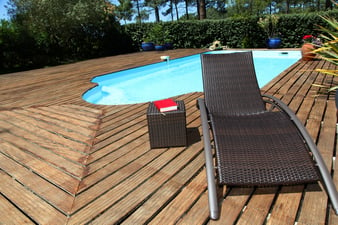Spa pools, hot tubs, whirlpool baths and other similar spa-systems have found steadily increasing popularity over many years in the UK and are now priced so that they are an achievable aspirational product for the home, having long been available in hotels, leisure centres etc.
So how can spa pools be managed safely?
Often marketed as a component part of our continual quest for a healthier lifestyle, their perceived therapeutic benefits are stated as including ‘the promotion of rapid healing of stressed or damaged muscles’, ‘relieving back and spine pain’, ’aiding the enjoyment of a deep and restful nights’ sleep’ or even allow us to ‘feel great, every day’ - perhaps with a glass of something white, chilled and fizzy in hand.
However, the HSE’s most recent guidance ‘HSG282: The control of legionella and infectious agents in spa-pool system’ [2017] in its introduction, is rather less enthusiastic, stating:
“Spa-pool systems are a recognised source of diseases caused by infectious agents including the organism that causes Legionnaires’ Disease, primarily Legionella pneumophila. There have been a number of outbreaks linked to spa pools in leisure centres, hotels, holiday homes, on cruise ships and on display.”
Ironically, this guidance was published the same week that courts confirmed that a prosecution for corporate manslaughter would be undertaken against JTF Wholesale, following two deaths from Legionnaires’ disease contracted from a hot tub on display in one of their stores in 2012. JTF fine £1m - BBC
What is a spa-pool?
 A spa pool in simple terms is a self-contained body of warm, agitated water designed for sitting or lying in [not for swimming]. Water is heated to between 30 – 40 Deg.C, filtered and chemically disinfected. They have air-jet circulation with or without air-induction bubbles and can be sited indoors or outdoors. These systems have the ability to produce aerosols, by means of air jets or similar devices.
A spa pool in simple terms is a self-contained body of warm, agitated water designed for sitting or lying in [not for swimming]. Water is heated to between 30 – 40 Deg.C, filtered and chemically disinfected. They have air-jet circulation with or without air-induction bubbles and can be sited indoors or outdoors. These systems have the ability to produce aerosols, by means of air jets or similar devices.
They can vary in size from the small domestic arrangement, to much larger facilities for commercial use. Given their size, they have a much higher ratio of bathers to water volume, than say a swimming pool, which in turn leads to a higher concentration of organic material from bathers within the pool.
The HSE make clear:
“these systems pose a reasonably foreseeable risk as they have environmental conditions that could potentially allow and support growth and dispersion of Legionella and other infectious agents where:
- Water is stored or recirculated;
- Water temperature in all or part of the system is between 20-45 Deg.C;
- These systems support microbiological growth;
- Water droplets are produced and dispersed as aerosols;
- There is potential for exposure to any contaminated aerosols.”
“Spa-pool systems must be managed carefully to ensure water quality does not encourage microbial growth and pose risks to users, people in the vicinity or passing near the spa pool.”
Microbiological risks and hazards
These are generally introduced from bathers or external sources ie the incoming water supply, atmosphere and surface surrounds. The risk of microbial growth increases with the introduction of nutrients from the bathers in the form of mucus, saliva, perspiration, dead skin, cosmetics, suntan lotions, urine or faecal matter. Poorly designed and managed spa-pool systems will provide ideal conditions that support and exacerbate risk associated with infectious diseases including Legionellosis, relating to coliforms and E.coli, Pseudomonas aeruginosa, Mycobacterium species or other amoebal, parasitic or gastrointestinal infections.
Long Standing Evidence of Legionella Risk
 A year-long study commissioned by the Health Protection Agency over 15 years ago and led by Dr Susanne Surman-Lee indicated that of 88 spa pools examined in sports clubs, health clubs and hotels, 23 contained Legionella bacteria. In 16 out of these 23 pools, routine bacteriological checks had been deemed as ‘acceptable’. Key findings also indicated that none of the failing pools were correctly managed or designed in accordance with guidance and there was evidence that staff had received inadequate Legionella training.
A year-long study commissioned by the Health Protection Agency over 15 years ago and led by Dr Susanne Surman-Lee indicated that of 88 spa pools examined in sports clubs, health clubs and hotels, 23 contained Legionella bacteria. In 16 out of these 23 pools, routine bacteriological checks had been deemed as ‘acceptable’. Key findings also indicated that none of the failing pools were correctly managed or designed in accordance with guidance and there was evidence that staff had received inadequate Legionella training.
Dr Surman-Lee indicated "We discovered that Legionella bacterium may be present in high numbers in both privately owned and public facilities, even when routine microbiological and safety checks appear satisfactory,"
Whilst this research focused solely on public and commercials facilities, a comparable risk is present within private/domestic facilities too, given their inherent and operational similarities.
Identifying and Assessing Risks
In identifying and assessing individual spa pool risks, as the 2017 guidance affirms;
“Before any formal health and safety management system is implemented the duty holder is responsible for ensuring a risk assessment is carried out to identify possible risks. The purpose of the assessment is to enable a decision to be taken on:
- The risk to health ie whether the potential for harm to health is foreseeable, unless adequate precautionary measure are taken;
- The necessary measure to prevent, or adequately control, the risk from exposure to Legionella and other infectious agents.
HSG282 Appendix Checklist 1 provides the basis for Risk Assessment.
Controlling the risk
 To ensure any pool remains safe to use, it remains clear ‘to control the risk, a course of action should be devised to manage the systems by implementing effective control measures’. ’A Water Safety Plan should be specific and tailored to the spa-pool system and any associated facilities, plant and equipment covered by the risk assessment’.
To ensure any pool remains safe to use, it remains clear ‘to control the risk, a course of action should be devised to manage the systems by implementing effective control measures’. ’A Water Safety Plan should be specific and tailored to the spa-pool system and any associated facilities, plant and equipment covered by the risk assessment’.
Similarly, guidance highlights too, that ‘communication and management procedures are particularly important where several people are responsible for different aspects of the spa pool’s operation.’ ‘Responsibilities and lines of communication should be clearly defined, reviewed and documented to ensure they are effective, and documentary evidence is made available for internal and external audits’.
HSG282 Appendix Checklist 2 provides the basis for a Water Safety Plan.
Responsibilities
It is accepted that general duties exist under the Health and Safety at Work etc. Act 1974 extending to risks for Legionella bacteria and other infectious agents which may arise from work activities, and duty holders must ensure the health safety and welfare of staff or others who may be affected by the systems in question.
All designers, manufacturers, suppliers and installers too, must ensure that spa pools are designed, constructed and tested, installed and commissioned so as to be safe for use. They must also provide information for the user abut the risks associated with the product. This remains true whether for commercial or domestic products.
Conclusion
One can only estimate at how closely either organisations or individuals follow the current HSE guidance for spa-pools, but there is a wealth of evidence that spa-pool systems remain a threat to both users and all those in their vicinity. It was reported recently that domestic spa pool sales were increasing 20% year on year and with this significant growth, one would expect to see a rise in total numbers of associated waterborne diseases.
Spa-pools must therefore be safely managed, with the aid of both the HSE’s and manufacturers’ guidance and instruction:
- Through effective design, commissioning, operation and maintenance;
- Testing and monitoring spa-pool water quality;
- Quality and frequency of inspections.
So when our increasingly stressful lives cry out for ‘a little oasis of calm’, ‘a calmer, more inviting place’ or a ‘chance to catch up with ourselves’ we may want to consider an alternative to the spa pool, or at least consider how effectively it is being managed and maintained…
Legionella in Hotels - Everything you need to know>
Feel free to reach out if you have any questions about this blog or if you would like to consult with one of our experts for further advice on water hygiene.
Editors Note: The information provided in this blog is correct at date of original publication - February 2019.
© Water Hygiene Centre 2019









